The Matra/Renault Espace
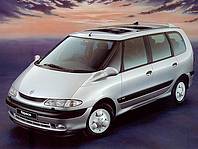 |
In 1978-1980, when researching for a successor for the Matra-Simca Rancho
(in its role as family all-purpose utility car) Matra came up with an innovative idea of a one-box car with 7
seats - suitable for the big family or for business/recreation - despite many different prototypes (see
Gallery2) it was initially known as project P17 and P18
Unfortunately PSA didn't think they had the money to invest in this new idea, Matra were turned down.
"such a car has no future" was the Peugeot/PSA response - so Matra simply turned
to Renault, who accepted the idea ... The P-18 was modified to use the longitudinally mounted
Renault engines, and the car (now P23) was given the by now very well known name: The
Renault Espace. |
The Espace was produced very much in the same way as the Murena, - with a
warmgalvanized steel chassis and polyester
bodywork, at Matras factory in Romorantin. Due to Matra's well-developed know-how into
this technology, the result is a car with exceptional rust protection, excellent handling and
ride-comfort - and obviously loads of space.
Due to a fairly low center of gravity, it even has quite expceptional handling for a car
of this size. I can confirm this, - having had an Espace JE into 4-wheel drifting on a winding
French road - rock solid, and not all that scary an experience, - (it wasn't really on purpose
... the road just suddenly disappeared, and it was dark ... :-)
The phase/type/model numbers ...
Over the almost 20 years, Matra produced 4 major models of the Espace. The different models
have model and phase-numbers associated with them, - and some confusion surrounds these, so I will
explain the system here.
The first model 'J11' was type or series 1 and came in two versions - phase 1 from 1984 to 1987, and
phase 2 from 1988 to 1990. The phase numbers are used for facelift versions.
The second generation 'J63' was type or series 2 from 1991 to 1996, and the final Matra designed and
built Espace, the 'JE', which was the first one with a transverse powertrain, was type or series 3.
The fourth generation designed and built by Renault on the Laguna floorpan is then the series/type 4
and has also had two phases so far.
Vehicle Identification Numbers - VINs
Often the question of how to identify a certain car arises, and obviously this should be fairly
easy, when using the VIN. However that requires some knowledge of how these are constructed. Based
on information I received from Roy Gillard (UK Matra club, and professional Espace mechanic) I
can pull out my own Espace as an example:
My car's VIN: VF8 J63 5 25 0 R 338260
| VF8 | Vehicle France Matra (VF1:Renault, VF3:Peugeot, VF7:Citroen, VF8:Matra) |
| J63 | the Model type
(in Renault terminology B = 5 door hatch; C = 3 door hatch; D = coupe;
E = convertible; J = people carrier; (so Scenic is also a 'J');
K = estate; L = saloon;) |
| 5 | engine type
(2 = petrol carburettor; 5 = diesel; 6 = petrol injection;
7 = petrol inj. unleaded type; 8 = V6 petrol) |
| 25 | gearbox type (manual 5 speed) |
| 0 | one-letter for model year * |
| R | build plant (R = Romorantin K = Dieppe) |
| the six digit number | this is the actual production number. |
* - the one-letter model year follows (at least initially) the same scheme
as other Matra cars, - i.e.
7 = 1977, 8 = 1978, 9 = 1979, A = 1980, B = 1981, C = 1982, D = 1983, E = 1984
Year letters continued for first Espace:
F = 1985 G = 1986 H = 1987 etc.
Assuming 'I' was not used because of possible confusion with a '1' (one)
J would be 1988, K would be 1989, L would be 1990, M would be 1991
N would be 1992, O would be 1993, P would be 1994, etc.
However, Renault do not use the letter O in chassis numbers because of
confusion with a 0 (zero) and that digit in various chassis numbers for
a variety of Espace from 1989 to 1994 ALL have a zero! So it appears
the year letter was dropped in 1989 or maybe 1988, and a zero substituted.
Since the year is supposed to be included in the 17 digit format they must
have another way of proving the date of manufacture - possibly from the
six digit production number at the end?
[1984-1988] The J11 type-1 (phase-1)
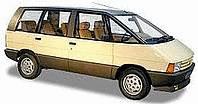
|
Since the Espace was originally concieved as a Talbot, the first version that came out
in 1984 had the then popular forward slanting headlights, and obviously borrowed a lot of
parts from the Talbot range. This version is named the J11 (factory code P23). As there was
later a faceliftet version called phase-2, it makes sense to add a "phase-1" for this initial
version.
|
[1988-1991] The J11 , type-1 , phase-2
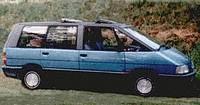
|
Obviously, now being badged a Renault, this had to be changed, so a few years later,
Matra made a facelift, to replace headlamps with the Renault style backward slanting type,
and also the interior was redesigned, to make use of the Renault parts bin. The chassis
was essentially unaltered. This car is referred to as J11 phase-2. (still factory code P23)
|
[1991-1997] The J63 - or type-2
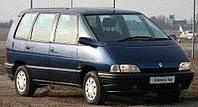
|
The J11-phase-2 was produced until 1991, when the car was modified substancially (while keeping
the concept). The chassis was redesigned, and the car looks much more rounded inside and out.
This was the J63 (factory code P36), which is easily recognized on its more rounded
shape and the side-mirrors, which were now integrated in the bonnet, - with a nice
design-line running across the bonnet, connecting the mirrors.
While this placement of the sidemirrors IMO is esthetically pleasing, it is also very
convenient, as you almost don't have to move your eyes, to notice whats going on in the mirrors
|
[1997-2002] The last Matra model, - the JE - or type-3
 In 1997, the car
was changed again. Chassis modifications made a transverse engine mounting possible, and on the
exterior side, it got an even more rounded and clean looking body fitted. The interior now sports
the "space-ship look" , with a digital speedometer in the centre of the dashboard. The dashboard
itself looks more like something you have in your livingroom (or your space-ship ?) , than a
traditional car - and is a testament to Matra's ingeniuity and willingness to dare take a step
away from mainstream - the precise feature that will make Matra remembered in many years to come. In 1997, the car
was changed again. Chassis modifications made a transverse engine mounting possible, and on the
exterior side, it got an even more rounded and clean looking body fitted. The interior now sports
the "space-ship look" , with a digital speedometer in the centre of the dashboard. The dashboard
itself looks more like something you have in your livingroom (or your space-ship ?) , than a
traditional car - and is a testament to Matra's ingeniuity and willingness to dare take a step
away from mainstream - the precise feature that will make Matra remembered in many years to come.
This car is named the JE or type-3 (factory code P52). It is recognized on its modern
front-grille and large sidemirrors, with an aircon-grille on it front-facing side. There is no
line across the bonnet, connecting the mirrors as on the P36/J63/type-2.
|
All the Matra Espace models are IMO wonderful cars, - and seen in their contemporary light,
each of them were miles ahead of the competition. Due to the exceptional durability, even the
very first models are still seen on the roads, - and the J11 makes just a good means of transport
as the JE, - there *are* differences, - but the concept and feeling is fairly much the same.
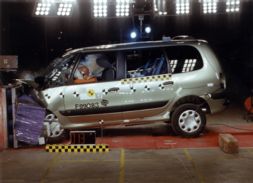 Safety is another area where the
method of having a real chassis underneath the fibreglass excels - you can design the chassis in
a way that will redirect the load much better, as it doesn't have to follow the cars exterior
design. The Espace JE (/type-3) scored
close to 5 stars in NCAP
crashtests - the same test that doomed the Opel/Vauxhall Sintra ,
the VW Sharan/Ford Galaxy and
the Chrysler Voyager
poor or downright dangerous (The Voyager scored a blank ZERO in frontal impact!).
Safety is another area where the
method of having a real chassis underneath the fibreglass excels - you can design the chassis in
a way that will redirect the load much better, as it doesn't have to follow the cars exterior
design. The Espace JE (/type-3) scored
close to 5 stars in NCAP
crashtests - the same test that doomed the Opel/Vauxhall Sintra ,
the VW Sharan/Ford Galaxy and
the Chrysler Voyager
poor or downright dangerous (The Voyager scored a blank ZERO in frontal impact!).
Add to this, that the chassis is fully warm-galvanized, so it will be almost as strong in
20 years, by which time most of the contemporary competitors will have rusted away, or become
very weak as a result of corrosion.
There is little doubt that this is a very popular design - today most car-companies have an
"Espace" or a "people-mover" (even Peugeot !) - "Multi Purpose Vehicle" (MPV) is the official
class the Espace more or less has founded. (someone at Peugeot must feel pretty stupid today :-)
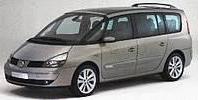 Matra turned over the Espace production to Renault in 2002, and since Renault does not have the
expertise or facilities to build cars the way Matra did, they redesigned it, and produced an
all-steel "ordinary" car (The available capacity on their traditional factories played a big role in
the wish to bring the Espace production in-house). In my eyes, however, this is a very sad development
indeed, - even if the Espace-IV really *is* a very nice car.
Matra turned over the Espace production to Renault in 2002, and since Renault does not have the
expertise or facilities to build cars the way Matra did, they redesigned it, and produced an
all-steel "ordinary" car (The available capacity on their traditional factories played a big role in
the wish to bring the Espace production in-house). In my eyes, however, this is a very sad development
indeed, - even if the Espace-IV really *is* a very nice car.
Steel cars of this size have a tendency of creating a booming noise inside, much more than a fibreglass
body, so in order to make the new Espace as silent and as safe as the predecessor, Renault have ended
up with a monster just over TWO TONNES (!). OK, they have dropped some really great and powerful engines
into it, - the new 2.2dci is *very* nice, and they even have produced a 3.0l dci engine, with monster
torque - but I see this more as a nessecity, since the car has become so heavy.
The Renault / Matra deal ...
In exchange for giving up the Espace production, Renault promised Matra they could develop their
new top-range luxury sort-of coupe-Espace. This became the Avantime
which really can be considered an Espace-coupe (hence it is "Espace DE", D for coupe). It uses almost
the same chassis in the lower part, but with the upper structure done in aluminium, to get the centre
of gravity even lower than the Espace. The bodywork is still polyester, which is bonded in place. The
doors are now a (galvanized) steel construction with polyester bodypanels bonded to it, making them
much stronger than standard Espace doors, which were all fibreglass, with a metal frame, and in later
models (J63 and JE) a side-impact steel bar about halfway up, on the inside.
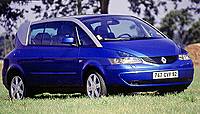
It is an avantgarde looking,
pillar-less Espace Coupe, - the target group was (according to Matra themselves) people whose kids have
left home, but who still prefers the style and flexibility of the Espace, spiced up with a more luxurious
interior. The car was unfortunately seriously delayed (some say Matra were focusing too much on production,
and too little on the look ahead?). One thing that certainly delayed the project was getting the pillar-less
design safety-approved, - the folding doors also proved difficult, - so there was a considerable delay in
launching the car.
in comes the Vel-Satis ...
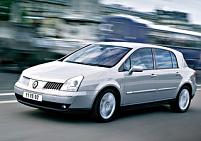 Renault had in the meantime tested their design study "Vel Satis" with the public at car-shows
in 1999, but told people that this was only a design study, and it would never be produced. Whatever
caused it (be it Matra delay, or the huge demand), Renault put the Vel Satis into production, and
hit the market about the same time as the Avantime was finally ready.
Renault had in the meantime tested their design study "Vel Satis" with the public at car-shows
in 1999, but told people that this was only a design study, and it would never be produced. Whatever
caused it (be it Matra delay, or the huge demand), Renault put the Vel Satis into production, and
hit the market about the same time as the Avantime was finally ready.
This obviously was not a good thing for Matra, who must have felt that Renault had not kept their
part of the deal. To add insult to injury, its no secret that Renault urged their sales-organisation
to push the Vel Satis before the Avantime (by offering higher bonuses to the sales-people)
This caused the Avantime to sell suficciently poor, to drain Matra for funds, and since there
were no hopes for Renault helping them out, Matra decided in december 2002 that enough was enough,
and in April 2003 they shut down Matra Automobile, - closed the factory in Romorantin and a little
later (August 2003) they sold off the test-track and prototype facility at CERAM/Chantillys (north
of Paris) to Pininfarina.
A future classic...
Only about 10.000 Avantimes were produced, - and being sort of a final development of an old
concept (like the Murena was to the Bagheera) this number certainly calls up a feeling of "deja vu" ...
One thing seems certain, - the small production-number and trendsetting design is sure to make the
Avantime a collectors item - a future classic. I WANT ONE. :-)
Special editions ...
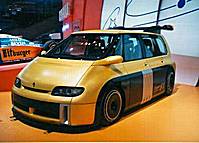 At the Paris Autoshow in 1994, Matra and Renault Sport presented the
Espace-F1
to the public. This car is a one-off showstopper, to celebrate the 10 year
anniversary of the Espace (and of Renault in Formula-1).
At the Paris Autoshow in 1994, Matra and Renault Sport presented the
Espace-F1
to the public. This car is a one-off showstopper, to celebrate the 10 year
anniversary of the Espace (and of Renault in Formula-1).
It is powered by a central rear-mounted RS4 Grand Prix engine, and it is also
equipped with F1 rear suspension, a breahtaking carbon body and a 6-speed
gearbox. It accelerates from 0 to 100 km/h in 2.896 seconds, - and from 0 to 200 km/h in 6.3 seconds - it brakes equally spectacularly,
slowing from 300 km/h to 70 km/h in just 80 metres. Top speed: well over 300 km/h. Dailymotion.com have a video of the Espace-F1 driven by Alain Prost here.
According to a Matra-Transport engineer, it goes from 0km/h to 270km/h and
back to 0km/h in less than 600 meters !
Links
http://www.espace-freunde.de/ - a great Espace site, in german
http://www.madcom.tv - a good source of Espace parts, near Kassel (Germany)
www.0-100.it - worlds fastest 0-100 km/h timesThe Espace-F1 is still in top-10 (!)




 In 1997, the car
was changed again. Chassis modifications made a transverse engine mounting possible, and on the
exterior side, it got an even more rounded and clean looking body fitted. The interior now sports
the "space-ship look" , with a digital speedometer in the centre of the dashboard. The dashboard
itself looks more like something you have in your livingroom (or your space-ship ?) , than a
traditional car - and is a testament to Matra's ingeniuity and willingness to dare take a step
away from mainstream - the precise feature that will make Matra remembered in many years to come.
In 1997, the car
was changed again. Chassis modifications made a transverse engine mounting possible, and on the
exterior side, it got an even more rounded and clean looking body fitted. The interior now sports
the "space-ship look" , with a digital speedometer in the centre of the dashboard. The dashboard
itself looks more like something you have in your livingroom (or your space-ship ?) , than a
traditional car - and is a testament to Matra's ingeniuity and willingness to dare take a step
away from mainstream - the precise feature that will make Matra remembered in many years to come. Safety is another area where the
method of having a real chassis underneath the fibreglass excels - you can design the chassis in
a way that will redirect the load much better, as it doesn't have to follow the cars exterior
design. The Espace JE (/type-3) scored
Safety is another area where the
method of having a real chassis underneath the fibreglass excels - you can design the chassis in
a way that will redirect the load much better, as it doesn't have to follow the cars exterior
design. The Espace JE (/type-3) scored
 Matra turned over the Espace production to Renault in 2002, and since Renault does not have the
expertise or facilities to build cars the way Matra did, they redesigned it, and produced an
all-steel "ordinary" car (The available capacity on their traditional factories played a big role in
the wish to bring the Espace production in-house). In my eyes, however, this is a very sad development
indeed, - even if the Espace-IV really *is* a very nice car.
Matra turned over the Espace production to Renault in 2002, and since Renault does not have the
expertise or facilities to build cars the way Matra did, they redesigned it, and produced an
all-steel "ordinary" car (The available capacity on their traditional factories played a big role in
the wish to bring the Espace production in-house). In my eyes, however, this is a very sad development
indeed, - even if the Espace-IV really *is* a very nice car. 
